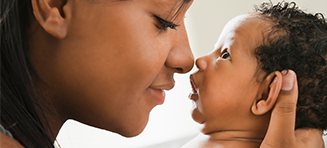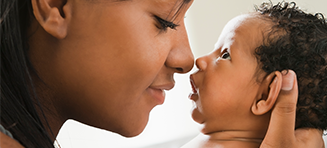
For Consumers
For Consumers
For Consumers
For Consumers
SYNAGIS helps protect your high-risk baby from severe RSV disease
If your baby is at high risk for severe RSV disease, you naturally want to do all you can to keep your little one at home and out of the hospital. SYNAGIS [si-nah-jis] helps protect babies from RSV through virus-blocking antibodies.
SYNAGIS is not a vaccine—it’s an injection given once a month throughout RSV season, which usually starts in the fall and continues into spring. The exact timing of RSV varies by location.

SYNAGIS gives babies who are born prematurely (at or before 35 weeks, and who are 6 months of age or less at the beginning of RSV season) the virus-blocking antibodies they lack, helping protect their vulnerable lungs from RSV.
SYNAGIS can help protect children with certain lung or heart conditions who are at high risk for severe RSV disease. Children with BPD/CLDP or HS-CHD are more likely to be hospitalized with an RSV infection than those without these conditions.
Remember, SYNAGIS is not a vaccine. Children can still get severe RSV disease despite receiving SYNAGIS. If your child has an RSV infection, make sure they continue to get their monthly injections throughout the RSV season—because babies can get RSV more than once.
BPD/CLDP stands for bronchopulmonary dysplasia/chronic lung disease of prematurity.
HS-CHD stands for hemodynamically significant congenital heart disease.

Each dose of SYNAGIS helps protect your child from severe RSV disease for about a month. SYNAGIS should be given to high-risk babies every 28-30 days during RSV season. Talk to your doctor about a dosing schedule appropriate for your area.
It's important that babies at high risk for severe RSV disease get every injection of SYNAGIS on time throughout the RSV season.
While SYNAGIS can help protect your baby from RSV, you should be aware of possible side effects associated with SYNAGIS.
Possible, serious side effects of SYNAGIS include severe allergic reaction, which may occur after any dose. Such reactions may be life-threatening or cause death.
Signs and symptoms of a severe allergic reaction could include:

Severe rash, hives,
or itching skin

Swelling of the lips,
tongue, or face

Swelling of the throat,
difficulty swallowing

Difficult, rapid, or
irregular breathing

Bluish color of skin, lips,
or under fingernails

Muscle weakness
or floppiness

Unresponsiveness
Common side effects of SYNAGIS include fever and rash.
These are not all the possible side effects of SYNAGIS. Tell your child’s healthcare provider about any side effect that bothers your child or that does not go away.
If your baby experiences a negative reaction to SYNAGIS, call your physician immediately.
To report SUSPECTED ADVERSE REACTIONS, contact 1-866-773-52741-866-773-5274.
PLAY VIDEO
SYNAGIS is a prescription medication that is injected (50 mg and 100 mg) in certain children to help prevent serious lung disease caused by respiratory syncytial virus (RSV). You should know that SYNAGIS is used to prevent RSV, and not to treat children who already have RSV, including children:
SYNAGIS is a prescription medication that is injected (50 mg and 100 mg) in certain children to help prevent serious lung disease caused by respiratory syncytial virus (RSV). You should know that SYNAGIS is used to prevent RSV, and not to treat children who already have RSV, including children:
You Should Know: It is not known if SYNAGIS is safe and works in children who are over 24 months old when they started taking SYNAGIS.
You Should Know: SYNAGIS may cause severe allergic reactions.
You Should Know: SYNAGIS is given by injection. If the child has a problem with bleeding or bruises easily, an injection could cause a problem.
Before the child takes SYNAGIS, you should tell the child’s healthcare provider about all their medical conditions and medicines including vitamins, supplements, and herbal remedies.
The most common side effects are fever and rash.
You Should Know: These are not all the possible side effects for SYNAGIS. For more information, ask the child’s healthcare provider or review the full Prescribing Information for SYNAGIS, including Patient Information.
If you suspect that a child has experienced a side effect, call the child’s healthcare provider. You may also report side effects to Sobi North America at 1-866-773-5274 or the US Food and Drug Administration (FDA) at 1-800-FDA-1088.
AstraZeneca has transferred all rights to SYNAGIS (palivizumab) to another manufacturer, Swedish Orphan Biovitrum AB (SOBI), in January of 2019. If you need SYNAGIS support, please contact SYNAGIS CONNECT® at (866)-285-8419(866)-285-8419.